
The country of Brazil occupies roughly half of South America, bordering the Atlantic Ocean. Brazil covers a total area of 8,514,215 km2 (3,287,357 sq mi) which includes 8,456,510 km2 (3,265,080 sq mi) of land and 55,455 km2 (21,411 sq mi) of water. The highest point in Brazil is Pico da Neblina at 2,994 m (9,823 ft). Brazil is bordered by the countries of Argentina, Bolivia, Colombia, Guyana, Paraguay, Peru, Suriname, Uruguay, Venezuela, and France.

Rio Grande do Sul is a state in the southern region of Brazil. It is the fifth-most populous state and the ninth-largest by area. Located in the southernmost part of the country, Rio Grande do Sul is bordered clockwise by Santa Catarina to the north and northeast, the Atlantic Ocean to the east, the Uruguayan departments of Rocha, Treinta y Tres, Cerro Largo, Rivera, and Artigas to the south and southwest, and the Argentine provinces of Corrientes and Misiones to the west and northwest. The capital and largest city is Porto Alegre. The state has the highest life expectancy in Brazil, and the crime rate is relatively low compared to the Brazilian national average. Despite the high standard of living, unemployment is still high in the state, as of 2017. The state has 5.4% of the Brazilian population and it is responsible for 6.6% of the Brazilian GDP.
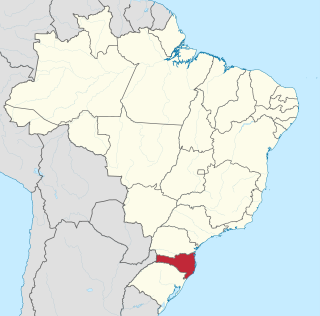
Santa Catarina is a state in the South Region of Brazil. Of Brazil's 26 states, it is the seventh-smallest state in total area and the 11th most populous. Additionally, it is the ninth-largest settlement, with 295 municipalities. The state, with 3.4% of the Brazilian population, generates 3.8% of the national GDP.
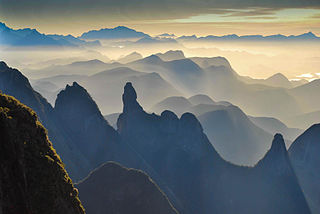
The Serra do Mar is a 1,500 km long system of mountain ranges and escarpments in Southeastern Brazil.

The Pelotas River is a river in southern Brazil, and a tributary of the Uruguay River.
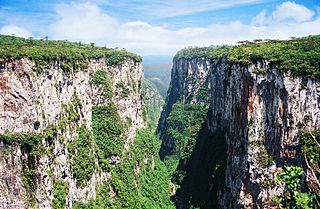
The Aparados da Serra National Park is a national park located in the Serra Geral range of Rio Grande do Sul and Santa Catarina states in the south of Brazil, between 29º07’—29º15’ S and 50º01’—50º10’ W. It was created in 1959 as one of Brazil's first national parks, to protect the Itaimbezinho canyon. It extends over an area of 10,250 hectares.

The Serra do Mar coastal forests is an ecoregion of the tropical moist forests biome. It is part of the Atlantic Forest of eastern South America. This ecoregion has an outstanding biodiversity consisting of flora, mammals, birds, and herpetofauna.
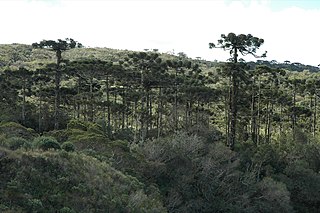
The Araucaria moist forests, officially classified as mixed ombrophilous forest in Brazil, are a montane subtropical moist forest ecoregion. The forest ecosystem is located in southern Brazil and northeastern Argentina. The ecoregion is a southern portion of the Atlantic Forest. The ecoregion also includes select areas of open field called "campos de cima da serra" or "coxilhas".
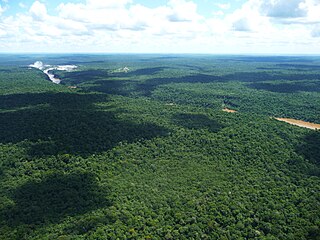
The Alto Paraná Atlantic forests, also known as the Paraná-Paraíba interior forests, is an ecoregion of the tropical moist forests biome, and the South American Atlantic Forest biome. It is located in southern Brazil, northeastern Argentina, and eastern Paraguay.
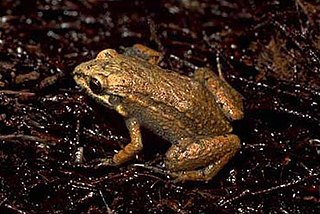
Adenomera araucaria is a species of frog in the family Leptodactylidae. It is endemic to southern Brazil, where it occurs in the southern part of the Serra Geral in the states of Santa Catarina and Rio Grande do Sul.

Cambará do Sul is a municipality in the state of Rio Grande do Sul, Brazil. Its population was approximately 6,406 in 2020. It has an area of approximately 1212 km².

Serra Geral National Park is a national park in the states of Rio Grande do Sul and Santa Catarina, Brazil.

The coastline of Brazil measures 7,491 km, which makes it the 16th longest national coastline of the world. All the coast lies adjacent to the Atlantic Ocean.
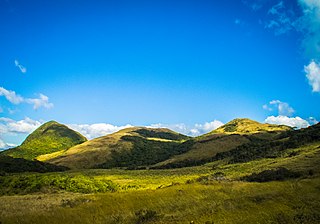
Serra do Tabuleiro State Park is a state park in the state of Santa Catarina, Brazil. It protects a mountainous area near the city of Florianópolis, covered in Atlantic Forest, which is an important source of drinking water. It also protects some coastal islands. The park is used for scientific research, education and eco-tourism.
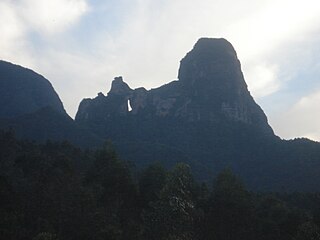
The Serra Furada State Park is a state park in the state of Santa Catarina, Brazil. It protects a densely forested mountain region of dramatic beauty in the Atlantic Forest biome.
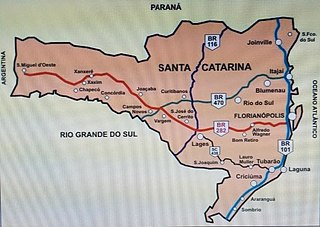
BR-470 is an east-west Brazilian federal highway that starts in Navegantes, Santa Catarina, and crosses the Gaucho range and highlands. It stretches approximately 833 km, passing through cities such as Itajaí, Blumenau, Rio do Sul, Curitibanos, Campos Novos, Bento Gonçalves, Veranópolis and Montenegro and ends in Camaquã, Rio Grande do Sul.
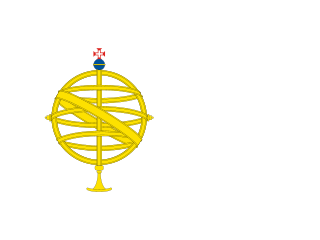
The Captaincy of Santa Catarina was an administrative division of colonial Brazil created on August 11, 1738, in the southernmost territories of the Captaincy of São Paulo. The government was officially installed on March 7, 1739, with the first governor being José da Silva Pais.

Mining in Paraná is a set of studies, research, knowledge, and theories regarding the mineralogical aspects of the state of Paraná, in Brazil. Paraná is the second federative unit of Brazil that produces the most talc, which is extracted in the municipality of Ponta Grossa. In 2016, it was responsible for 40% of the country's production, ahead of Bahia and São Paulo. It is the sixth state that produces the most silver, behind Mato Grosso. Coal, dolomite, limestone are also found in Paraná. Shale (schist) is also extracted, which, when heated, provides natural gas, sulfur, and other fuels. Petrobrás developed a shale industrialization program, which includes a plant in São Mateus do Sul, in the south of the state.

Campos de Cima da Serra, also known as Campos de Vacaria, is a Brazilian physiographic region in the Rio Grande do Sul, located in the far northeast of the state, bordering Santa Catarina. It comprises the main municipalities of Bom Jesus, Cambará do Sul, Campestre da Serra, Capão Bonito do Sul, Esmeralda, Ipê, Jaquirana, Lagoa Vermelha, Monte Alegre dos Campos, Muitos Capões, Pinhal da Serra, São Francisco de Paula, São José dos Ausentes, and Vacaria. Its total area is 21,033 square kilometers. It is located at altitudes ranging from 900 meters in the west to 1,200 meters in the Aparados da Serra. The region is characterized by gently rolling terrain deeply cut by several rivers and consists of an elevated plain with basaltic soil that slopes to the west. The predominant vegetation is grasslands with occasional stands of Araucaria trees.




















